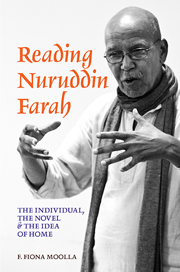Book contents
- Frontmatter
- Contents
- Introduction
- 1 Defining the Individual: Conceptual & Historical Limits
- 2 From a Crooked Rib & the Bildungsroman: Developing the Self, Developing the Nation
- 3 The ‘Gynocentric’ Bildungsroman: Sardines & Gifts
- 4 Modernism in A Naked Needle & Sweet & Sour Milk: Irony, Morality & the Aesthetic
- 5 Close Sesame & the Representation of Heteronomy
- 6 Dissolving the Boundaries of Self & Nation in Maps & Secrets
- 7 Reconstructing the Subject in the Third Trilogy: Links, Knots & Crosbones
- Conclusion
- Bibliography
- Index
4 - Modernism in A Naked Needle & Sweet & Sour Milk: Irony, Morality & the Aesthetic
Published online by Cambridge University Press: 05 April 2014
- Frontmatter
- Contents
- Introduction
- 1 Defining the Individual: Conceptual & Historical Limits
- 2 From a Crooked Rib & the Bildungsroman: Developing the Self, Developing the Nation
- 3 The ‘Gynocentric’ Bildungsroman: Sardines & Gifts
- 4 Modernism in A Naked Needle & Sweet & Sour Milk: Irony, Morality & the Aesthetic
- 5 Close Sesame & the Representation of Heteronomy
- 6 Dissolving the Boundaries of Self & Nation in Maps & Secrets
- 7 Reconstructing the Subject in the Third Trilogy: Links, Knots & Crosbones
- Conclusion
- Bibliography
- Index
Summary
Philosophy is the real homeland of irony, which one would like to define as logical beauty …
(Friedrich Schlegel, fragment 42 from “Critical Fragments”, 1797)The analysis of Gifts in the previous chapter suggested resolution of the contradiction of individualist subject formation through the principle of textuality. Aesthetic resolution of the inherent contradiction of individualism, in fact, achieves its clearest expression in A Naked Needle, a much earlier novel. The techniques of modernism employed in this novel ultimately allow form, the aesthetic, to represent the higher order which realism could not, without tension, allow to emerge from the autonomous self.
Literary modernism is probably the most significant influence on the novels of Nuruddin Farah. With the exception of From a Crooked Rib which shares realism's preoccupation with presenting a convincing character who constructs a moral order from reason and personal experience, the subsequent novels draw on the techniques of the “postindividualist” order scripted by modernism. Modernism informs Farah's novels in various ways. In fact, the trilogy form used by Farah, in which particular themes are fully developed over three novels, is strongly influenced by Samuel Beckett's trilogy of novels Molloy, Malone Dies and The Unnamable. Many of the epigraphs which introduce the novels and sections of novels are drawn from the works of modernist writers like Yeats and Conrad. Often in their structure, the novels allude to other modernist novels. A case in point is the similarity of the structure of Sardines to Virginia Woolf's Mrs Dalloway, referred to in more detail in the earlier discussion of the transformation of the classical Bildungsroman in some of the novels.
- Type
- Chapter
- Information
- Reading Nuruddin FarahThe Individual, the Novel and the Idea of Home, pp. 104 - 121Publisher: Boydell & BrewerPrint publication year: 2014



